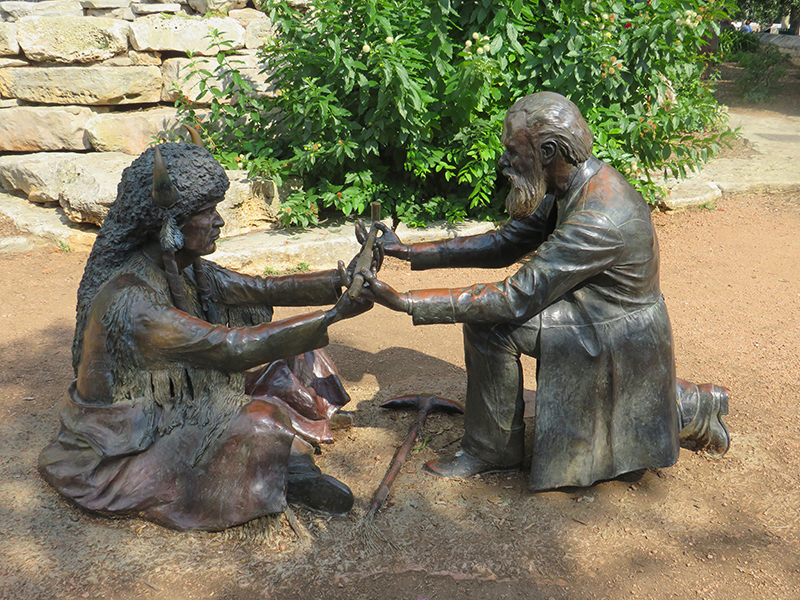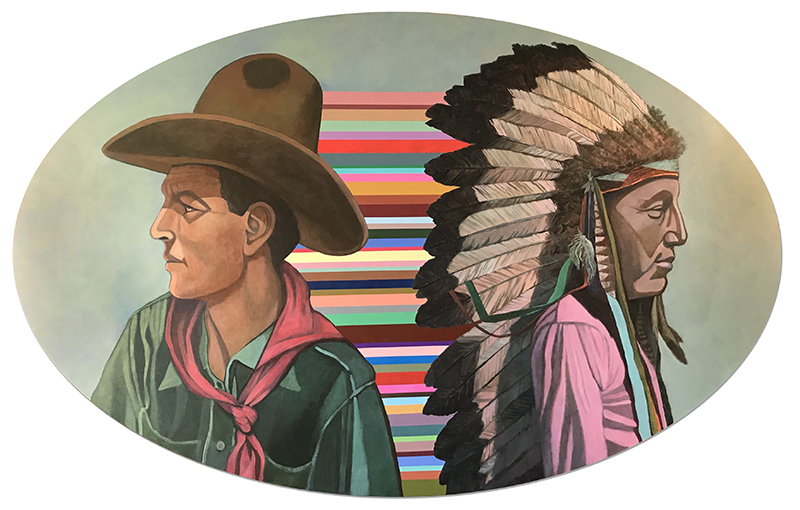Anglo-Texans and Native Americans, like Israelis and Palestinians, have a troubled history. Between 1840 and 1880, settlers and Indians clashed in a deadly guerrilla war along the Texas frontier. Only in the Hill Country did the Germans and the Natives find a way to occupy the same territory with some level of civility.
The savagery of the larger conflict opened wounds that never completely healed. Hard feelings lasted for generations. As a result, Native groups never received the study, recognition or respect they deserved. Some tribes died out completely, their histories, cultures and identities unrecorded.
The long-term effects of the bloody Indian wars hit Texas tribes especially hard. While most western and southwestern states have significant amounts of Indian lands, Texas has only three small reservations: the Alabama-Coushatta near Livingston, the Kickapoo near Eagle Pass and the Ysleta del Sur Pueblo in El Paso.
In light of the loathing many 19th-century Texans had for Indians of any stripe, the mostly peaceful relationship between the Germans and the Hill Country Natives stands out. As a rule, the Germans, unlike many other settlers, treated all Indians as fellow human beings, worthy of respect. That treatment set a tone that allowed the German Hill Country to experience a level of calm the rest of the Texas frontier did not enjoy.
Several distinct Native tribes occupied the Texas Hill Country, or at least laid some claim to it, when the Germans arrived. Those Natives, while generically referred to as Indians, constituted several unique tribes, different in culture and language.
Modern-day experts know little about the Lipan Apache, although they once roamed much of the southern plains and western Texas including the Hill Country. Never as fearsome as the Mescalero and Chiricahua Apache of New Mexico and Arizona, the Lipan lived quietly, raising maize, beans, squash and pumpkins, until they discovered the horse in the second half of the 17th century. After the Lipan learned to ride, they forgot how to farm. Stealing food turned out to be easier than growing it.
The horse allowed the Lipan to follow and hunt buffalo in the fall and spring when the animals concentrated in enormous herds on the southern plains. The Lipan, however, gave plenty of room to the Comanche who had already staked a claim to the plains and didn’t take kindly to trespassers.
Then sometime before the Germans came to Texas, Lipan culture began a slow decline. Weakened by disease and dominated by more powerful tribes, the Lipan sought safety in alliances with other Indians, with the Spanish and even with the Texas Rangers. W.W. Newcomb Jr., author of The Indians of Texas: From Prehistoric to Modern Times, described them as “once a gathering and hunting people, they next became hunters, and finally poverty-stricken hunters and gatherers.” They had a reputation as beggars and thieves. By 1850 many settlers considered the Lipan more of a nuisance than a serious threat to settlement.
The Tonkawa, like the Lipan wandered afoot until they discovered horses. On horseback they learned to hunt buffalo. Newcomb Jr. wrote, “Unquestionably the Tonkawa, once they were mounted on horses, would have abandoned Central Texas for the richer buffalo plains to the north and west had they been able to do so. But early in the eighteenth century the powerful Comanche and other plains tribes preempted this bountiful land.”
As the buffalo disappeared from the Central Texas, the Tonkawa hunted deer and turkeys although they found deer easier to kill. If a deer spotted a stalking Tonkawa, the hunter would remain perfectly still. The deer would gaze suspiciously at the stalker for a few minutes until reassured. “But let a turkey catch sight of a suspicious object,” Newcomb Jr. wrote, “and he didn’t wait to investigate it.”
The Tonkawa used juice from the mistletoe leaf to make poison arrows although mistletoe juice turned out to be harmless. Still, as Newcomb Jr. noted, “when the Tonkawa obtained firearms, they continued the practice by putting the juice in the barrels of their guns.”
By the 19th century the fading Tonkawa found themselves caught between the powerful Comanche to the west and the relentless Anglo settlement from the east. “Some other people might have made a better show of resistance,” Newcomb Jr. wrote, “but such was not the nature of the timid Tonkawa.”

Of the many adjectives used to the Comanche, the word timid never made the list. Undistinguished as warriors until they discovered the horse, the Comanche became perhaps the greatest light cavalry ever assembled. They were ferocious fighters, the equal of any troops that rode against them. S.C. Gwynne, author of Empire of the Summer Moon, called them “a people so fierce, they managed to delay and actually reverse white settlement in Texas for a period of time.”
The Comanche refused to fight in traditional ways, preferring instead to use guerrilla tactics. They set the Texas frontier ablaze. Settlers had trouble even taking ownership of western lands because surveyors did not live long enough to establish boundaries and property lines. “The problem,” Gwynne pointed out, “was that the Comanche, understanding that the surveyors were stealing their land, killed surveyors in horrible ways.”
When the Germans founded Fredericksburg in 1846, with plans for additional settlements beyond the Llano River, The Comanche stood squarely in the way. It is doubtful that Fredericksburg could have survived without a peace treaty.
And so a party of Germans, led by John O. Meusebach, met the Comanche chiefs in March 1847 on the lower San Saba River, about 25 miles above its junction with the Colorado. The remarkable agreement they reached allowed the Germans to move unharmed in Comanche territory. The Comanche received the same consideration in the German settlements.
Then on May 9, 1847, Chiefs Ketemoczy and Santana led a delegation of Comanche to Fredericksburg for the treaty ratification ceremony, signaling the start of a unique relationship based on trust and respect, not fear. “The Indians,” local historian Elise Kowert wrote, “brought with them tanned hides, bear fat and deer skins filled with honey.” They staged “ceremonial dances in the street.” Then the Germans danced at Marketplatz. “Just as the white settlers wondered in amazement at the Indian dances, so the Indians stood in wonderment as the Germans swirled through their schottisches, waltzes and gallops.”
In the early years the Germans and the Natives depended on each other for life’s necessities. The Germans traded with the Indians for food. The Indians came to the German settlement for medical treatment.
Dr. Wilhelm Keidel treated Indians, probably Tonkawa, at his home on Bear Creek. The Indians paid him by leaving dressed deer carcasses and wild turkeys hanging from a tree in his yard.
After the treaty, the German Hill Country became less dangerous. Surveyors no longer had to fear for their lives. Capt. Jack Hayes, Texas Ranger and surveyor, confirmed his ability to move about the Hill Country freely and unmolested, as long as he remained within the boundaries of the German colony.
The German settlers still had problems aplenty, but good relations with the Natives made Hill Country life a little easier. While much of the West Texas perimeter went up in smoke, Fredericksburg and the German colonies put down roots and gained a toehold on the precarious Texas frontier.


